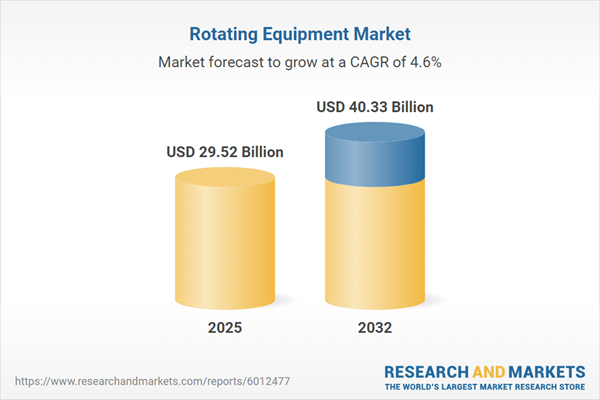Speak directly to the analyst to clarify any post sales queries you may have.
The rotating equipment market is evolving rapidly, shaped by complex supply chain dynamics, regulatory change, and advancing technologies. Senior executives navigating industrial transformation require concise, strategic insights to guide investments and maintain operational resilience in this shifting landscape.
Market Snapshot: Rotating Equipment Market Performance and Key Growth Trends
The Rotating Equipment Market grew from USD 28.24 billion in 2024 to USD 29.52 billion in 2025. It is expected to continue growing at a CAGR of 4.55%, reaching USD 40.33 billion by 2032. As industry sectors intensify their focus on efficiency, reliability, and sustainability, purchasing criteria and supplier strategies are rapidly evolving. Decision-makers are challenged by disruptive innovations, shifting regulatory requirements, and the critical need for robust, future-ready rotating equipment portfolios.
Scope & Segmentation: Rotating Equipment Market Coverage
- Product Types: Compressors (Centrifugal, Reciprocating, Rotary); Fans & Blowers (Axial Fans, Blowers, Centrifugal Fans); Mixers & Agitators (Dynamic, Static); Pumps (Centrifugal, Positive Displacement); Turbines (Gas, Steam, Wind); Vacuum Pumps (Dry, Wet)
- End Use Industries: Chemical & Petrochemical (Basic Chemicals, Petrochemicals, Specialty Chemicals); Food & Beverage (Bakery, Beverages, Dairy); Mining & Minerals (Coal, Metal & Mineral, Non-metallic Minerals); Oil & Gas (Downstream, Midstream, Upstream); Pharmaceuticals (Bulk Drugs, Formulations); Power Generation (Hydro, Nuclear, Renewable, Thermal); Water & Wastewater (Industrial, Municipal)
- Configuration: Horizontal (Multi-Stage, Single-Stage); Vertical (Multi-Stage, Single-Stage)
- Drive Types: Diesel Engine Driven; Electric Motor Driven (Induction Motor, Synchronous Motor); Gas Turbine Driven; Steam Turbine Driven
- Material Selection: Alloy Steel; Cast Iron; Stainless Steel (SS304, SS316, SS316L)
- Regional Coverage: Americas (North America: United States, Canada, Mexico; Latin America: Brazil, Argentina, Chile, Colombia, Peru); Europe, Middle East & Africa (Europe: United Kingdom, Germany, France, Russia, Italy, Spain, Netherlands, Sweden, Poland, Switzerland; Middle East: United Arab Emirates, Saudi Arabia, Qatar, Turkey, Israel; Africa: South Africa, Nigeria, Egypt, Kenya); Asia-Pacific (China, India, Japan, Australia, South Korea, Indonesia, Thailand, Malaysia, Singapore, Taiwan)
- Featured Companies: Siemens Energy AG, General Electric Company, Atlas Copco AB, Ingersoll Rand Inc., Flowserve Corporation, Sulzer Ltd., Weir Group plc, KSB SE & Co. KGaA, SPX FLOW, Inc., Ebara Corporation
Key Takeaways for Senior Decision Makers
- Industry 4.0 technologies, including sensor integration and digital twins, are driving predictive maintenance and optimizing equipment lifecycle costs.
- Decarbonization efforts and tighter emissions standards are prompting a shift to energy-efficient turbine designs and advanced, sustainable materials.
- Tariff changes, especially those affecting steel and aluminum, are redefining sourcing strategies and amplifying regional supply chain resilience.
- Mergers and acquisitions are expanding technical capabilities and geographic reach while enhancing aftermarket and service propositions.
- Collaborative innovation between OEMs, software developers, and research institutes is accelerating the development of next-generation components.
- Growing demand in Asia-Pacific and large-scale modernization in the Americas and EMEA region are creating distinct opportunities and challenges in project execution and product adaptation.
Tariff Impact: Navigating Supply Chain Strategies
The introduction of new United States tariffs on key raw materials and imported components has altered the cost dynamics for rotating equipment. Manufacturers are pivoting to alternative suppliers and integrating dual-sourcing models, improving resilience but increasing complexity in inventory and capacity planning. Contract negotiation now requires greater transparency around cost structures and risk-mitigation, while regional sourcing strategies are gaining momentum among both established players and new entrants.
Methodology & Data Sources
This report leverages a rigorous methodology, combining over sixty primary interviews with C-level leaders and technical experts across industries and regions. Secondary research from peer-reviewed journals, patents, and corporate filings validates and triangulates key insights. Peer review and statistical validation ensure data quality and reliability throughout every stage of analysis.
Why This Report Matters
- Enables strategic investment planning by synthesizing emerging trends, technology adoption, and regional priorities in the rotating equipment market.
- Empowers executives and engineering teams to align portfolios with regulatory and sustainability requirements while maximizing operational performance.
- Provides actionable guidance for resilient sourcing, digital transformation, and collaborative innovation in a highly dynamic industrial environment.
Conclusion: Strategic Focus for the Rotating Equipment Industry
Sustained growth in the rotating equipment market requires embracing technology, strengthening regional capabilities, and fostering collaborative partnerships. By prioritizing digitalization, supply chain agility, and sustainability, senior leaders will position their organizations for long-term advantage in a fast-changing sector.
Additional Product Information:
- Purchase of this report includes 1 year online access with quarterly updates.
- This report can be updated on request. Please contact our Customer Experience team using the Ask a Question widget on our website.
Table of Contents
3. Executive Summary
4. Market Overview
7. Cumulative Impact of Artificial Intelligence 2025
Companies Mentioned
The companies profiled in this Rotating Equipment market report include:- Siemens Energy AG
- General Electric Company
- Atlas Copco AB
- Ingersoll Rand Inc.
- Flowserve Corporation
- Sulzer Ltd.
- Weir Group plc
- KSB SE & Co. KGaA
- SPX FLOW, Inc.
- Ebara Corporation
Table Information
| Report Attribute | Details |
|---|---|
| No. of Pages | 187 |
| Published | October 2025 |
| Forecast Period | 2025 - 2032 |
| Estimated Market Value ( USD | $ 29.52 Billion |
| Forecasted Market Value ( USD | $ 40.33 Billion |
| Compound Annual Growth Rate | 4.5% |
| Regions Covered | Global |
| No. of Companies Mentioned | 11 |









